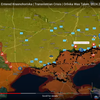Jóhannes Sigfússon, bóndi á Gunnarsstöðum í Þistilfirði.
Við verðum að koma böndum á þetta, við erum að missa landið úr höndum okkar.
Það að selja hlunnindajörð út úr sveitarfélagi er rétt eins og að selja kvóta út úr sjávarplássi.
Stærsta ferskvatnsforðabúr Evrópu í hendur útlendinga
Grímsstaðir á Fjöllum er stærsta einstaka ferksvatnsforðabúr í Evrópu.
Hafi einhvern tíma verið ástæða fyrir ríkið að koma að málum þá var það við sölu á þeirri jörð. Ríkið átti síðan einfaldlega að lýsa þetta land sem þjóðlendu,“ segir Jóhannes.
Vatn, vatnsfall, og veiðiréttindi, er gullnáma til framtíðar litið.
Það virðist enginn þora að rísa upp
„Það er alveg svakalegt hvað hér er að gerast. Það virðist enginn þora að rísa upp. Menn verða líka að gera sér grein fyrir því að landbúnaðurinn á Íslandi keppir ekkert um jarðirnar við þessa stórefnamenn.
000
Ætti að vera í lögum að banna erlendum
aðilum fjöldakaup á jörðum á Íslandi
– að mati Jóhannesar Sigfússonar, bóndi á Gunnarsstöðum í Þistilfirði
http://www.bbl.is/files/pdf/bbl.-12.tbl.2018_web_ii.pdf
Erlendis eru svona uppkaup jarða bönnuð
Hér eru setningar úr greinum í BÆNDABLAÐINU,eftir,
Jóhannes Sigfússon, bóndi á Gunnarsstöðum í Þistilfirði.
000
slóð
slóð
slóð
Egilsstaðir, 23.06.2018 Jónas Gunnlaugsson







Athugasemdir
"First Bank of the United States (BUS). It was created, in 1791 and chartered for 20 years, to 1811.
Second Bank of the United States (SBUS), in 1816.
The Federal Reserve act and the sixteenth amendment, which gave congress the power to collect income taxes, were both passed in 1913"
A must read, Athuga vel.
“Thomas Jefferson said,
"If the America people ever allow private banks to control the issuance of their currencies,
first by inflation and then by deflation, the banks and corporations that will grow up around them
will deprive the people of all their prosperity until their children will wake up
homeless on the continent their fathers conquered”
A must read Athuga vel
http://www.john-f-kennedy.net/thefederalreserve.htm
“They influenced Congress to charter the second central bank,
the Second Bank of the United States (SBUS), in 1816.
The SBUS was more expansive than the BUS.
The SBUS sold franchises and literally doubled the number of banks in a short period of time.
The country began to boom and move westward, which required money.
Using fractional lending at the 10:1 rate, the central bank and their franchisees
created the debt/money for the expansion.
-
Things boomed for a while,
then the banks decided to shut off the debt/money,
citing the need to control inflation.
-
This action on the part of the SBUS caused bankruptcies and foreclosures.
The banks then took control of the assets that were used as security against the loans.
-
Closely examine how the SBUS engineered this cycle of prosperity and depression.
The central bank caused inflation by creating debt/money for loans and credit
and making these funds readily available.
The economy boomed.
*
Then they used the inflation which they created as an excuse to shut off the loans/credit/money.
The resulting shortage of cash caused the economy to falter or slow dramatically
and large numbers of business and personal bankruptcies resulted.
The central bank then seized the assets used as security for the loans.
***
The wealth created by the borrowers during the boom was then transferred
to the central bank during the bust.
***
And you always wondered how the big guys ended up
with all the marbles.
*
Now, who do you think is responsible for all of the ups and downs
in our economy over the last 85 years?
*
Think about the depression of the late '20s and all through the '30s.
The FED could have pumped lots of debt/money into the market
to stimulate the economy and get the country back on track,
but did they?
No; in fact, they restricted the money supply quite severely.
We all know the results that occurred from that action, don't we?
Why would the FED do this?
During that period asset values and stocks were at rock bottom prices.
Who do you think was buying everything at 10 cents on the dollar?
I believe that it is referred to as consolidating the wealth.
How many times have they already done this in the last 85 years?
Do you think they will do it again?
Just as an aside at this point, look at today's economy.
Markets are declining.
Why?
Because the FED has been very liberal with its debt/credit/money.
The market was hyper inflated.
Who creates inflation?
The FED.
How does the FED deal with inflation?
They restrict the debt/credit/money.
What happens when they do that?
The market collapses.
Several months back, after certain central banks said they would be selling large quantities of gold,
the price of gold fell to a 25-year low of about $260 per ounce.
The central banks then bought gold.
After buying at the bottom, a group of 15 central banks announced
that they would be restricting the amount of gold released into the market
for the next five years.
The price of gold went up $75.00 per ounce in just a few days.
How many hundreds of billions of dollars did the central banks make
with those two press releases?”
http://www.herad.is/y04/1/2010-01-20-Midbankinn.htm
http://www.herad.is/y04/1/2011-05-09-eg-er-heimsbankinn.htm
http://www.herad.is/y04/1/2011-02-08-tiu-sinnum-innlan.htm
http://www.herad.is/y04/1/2010-10-31-samhengi.htm
Jónas Gunnlaugsson, 24.6.2018 kl. 08:10
Bæta við athugasemd [Innskráning]
Ekki er lengur hægt að skrifa athugasemdir við færsluna, þar sem tímamörk á athugasemdir eru liðin.